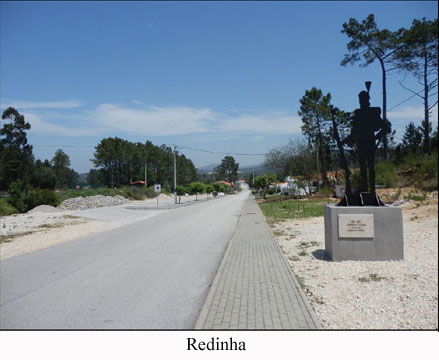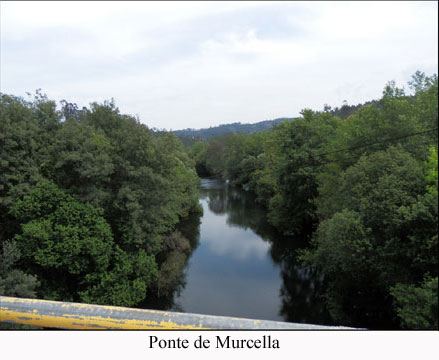
Chapter 32
Massena's Retreat from
Portugal
Mar - April 1811
See
Redinha Battle Plan
On
4th March, Massena began his retreat sending Marchand
to Leira. Wellington must have been aware that this move
was imminent as on the same day an order was issued to
Pack:
“Brigadier General
Pack and Major General Howard’s Brigade, to move
towards Azambuja. These arrangements are ordered with
the view of being prepared to follow the enemy should
he move off…. Lord wellington wishes you therefore
to be prepared to advance by the bridge of Calhorice.” |
 |
On 6th March
Wellington found Santarem deserted
and immediately dispatched the Light Division and the
1st Division in hot pursuit through the burned out villages
of Alcobaca and Batalha, they were at Leira by 9th, Venda
Nova by 10th and caught up with Ney’s rear guard
at Pombal on the 11th. The French left devastation in
their wake, to quote Oman:
“Picton, not
a man easily to be moved by sentiment wrote: ‘Nothing
can exceed the devastation and cruelties committed by
the enemy during his retreat: he has set fire to all the
villages and murdered all the peasantry for leagues on
each side of his march.’”
Pack was sent off further
to the north east through Alcanhede, Zebreira, Pialvo
to meet up with the Light and First Divisions at Pombal
on the 11th March where the enemy was engaged. An action
also took place at Redinha |
on
the following day, 12th March in which Wellington’s
leading columns with Pack in the centre, the Light Division
on the left and Picton with the 3rd Division on the right,
came up against Massena’s rear guard under Marshal
Ney. Pack was halted in the centre (receiving artillery
fire, which resulted in some significant casualties amongst
the Portuguese Cacadores Battalions) whilst the 2 other
Divisions attempted to outflank the French, who eventually
retreated towards Condeixa. Massena’s initial intention
was not to evacuate Portugal altogether only to cross
the Mondego river but he was unable to advance north in
the face of Trant’s militia who with 5,000 men,
guarded the partially destroyed bridge at Coimbra. Therefore,
with the allied army closing in on him from behind, on
13th March, he gave instructions to head east to Celorico
and the Spanish frontier. On 13th/14th March, Pack was
on the road between Condeixa and Casal Novo where |
an action
took place in thick fog and Erskine failed to appreciate
the strength of the French battalions in front of him.
It mainly involved the Light Division who were in the
lead, with Pack in support behind. Pack’s orders
on the 14th were to ford the river Esse below Miranda
de Corvo and ascend the ridge of Nostra Senhora de
Serra on the opposite side of the river to threaten the
enemy covering the bridge at Miranda de Corvo. The following
day there was another action at the village of Foz
D’Arouce which again involved the Light Division
and Picton with Pack’s Brigade in support on the
left, followed by a further advance to Ponte
de Murcella which was forced by the Light Division
on the 18th March. Pack was ordered the following day
to move from Ponte de Murcella through Cortica to Moita
where his Brigade was forced to halt through serious lack
of provisions. Wellington’s army was running out
of provisions as he was a long way from his depots in
Lisbon and movement of supplies to Coimbra by ship had
not yet got underway.
|
 |
The Portuguese
brigades and Pack in particular were in a much worse situation,
having received no regular rations for 4 days and wrote
to Wellington on the 21st complaining of:
“..bad commissariat and worse medical establishment
of an inefficient and penniless government which no officer
can serve with pleasure or advantage.” |
 |
He received a sympathetic
response from Sir George Murray, on the 27th March, but
no material help:
“I have shown
the letter I received from you to Lord Wellington who
intends making a representation to Lisbon upon the deficiency
in the supply of the Portuguese troops. In the meantime,
I am sorry however that I can hold out to you no prospect
of assistance from the British Commissariat and indeed
great embarrassment has been experienced up to this date
in bringing forward provisions for the British troops
and other corps which it is obliged to furnish and considerable
privations have been and are still experienced.
Lord Wellington recommends that you should march your
brigade to Coimbra unless your prospects of being supplied
have improved and for my own part I am inclined to think
that you will not miss much service by not being up at
present with the front of the army.” |
In
Haliday’s book: ‘The present state of Portugal
and the Portuguese Army’ published in 1812, he confirms
the parlous state of the Portuguese supply system:
“The commissariat
department of the Portuguese Army was conducted ‘till
lately upon principles so bad, that although the expense
was enormous and beyond all calculation, the army on almost
every occasion was actually starved. On the advance from
Santarem to Almeida in the spring of 1811, the Portuguese
Army was often without bread for weeks together and frequently
without meat ….” |
Subsequently, on the
30th March, Pack was advised by Murray to march his Brigade
to Mangoalde which lies between
Vizeu and Celorico, to be better positioned to be re-supplied.
By March 22nd, Massena was at Celorico and instead of
falling back on his base around Almeida and Ciudad Rodrigo
he decided on a march to the south east from which he
could threaten central Portugal. He fell out with Marshal
Ney who refused to obey his orders because his Corps was
starving and ill equipped. Ney was relieved of his command
and straight away returned to France to the dismay of
his troops. He was succeeded in the 6th Corps by Marshal
Loisson. In fact, the army of Portugal only reached the
area around Penamacor, Belmonte, Sabugal and Guarda before
Massena was persuaded that his plans were unworkable and
on the 29th March, gave the order to retreat on Ciudad
Rodrigo. On the same day, Wellington’s advance troops
appeared on the hills surrounding Guarda and the French
|
 |
retreated
in haste towards Sabugal, the British taking 2,300 prisoners.
The Combat at Sabugal took place a few days later on 3rd
April 1811 and resulted in a defeat for Massena’s
left wing who on 4th April were forced to retreat towards
Rodrigo via Alfayettes where Wellington later made his
headquarters. On 8th April the French Army of Portugal
retired northwards from the frontiers of Leon to Salamanca,
Toro and Zamora.
Pack, who had followed Murray’s suggestion and moved
to Mangoalde and who was still there on the 10th April,
received orders to march through Fornos, D’Algodres
and Pinhel to the villages of Torpin, Arre Villas on the
right bank of the Coa river and blockade the fortress
of Almeida which was still in French hands. The French
army of Portugal was in disarray and disorganised prompting
Napoleon to appoint Marmont in place of Massena. This
change in command didn’t take place until the dispatch
from Napoleon reached Massena at Ciudad Rodrigo on the
10th May 1811. |
Maps
Photos

|





